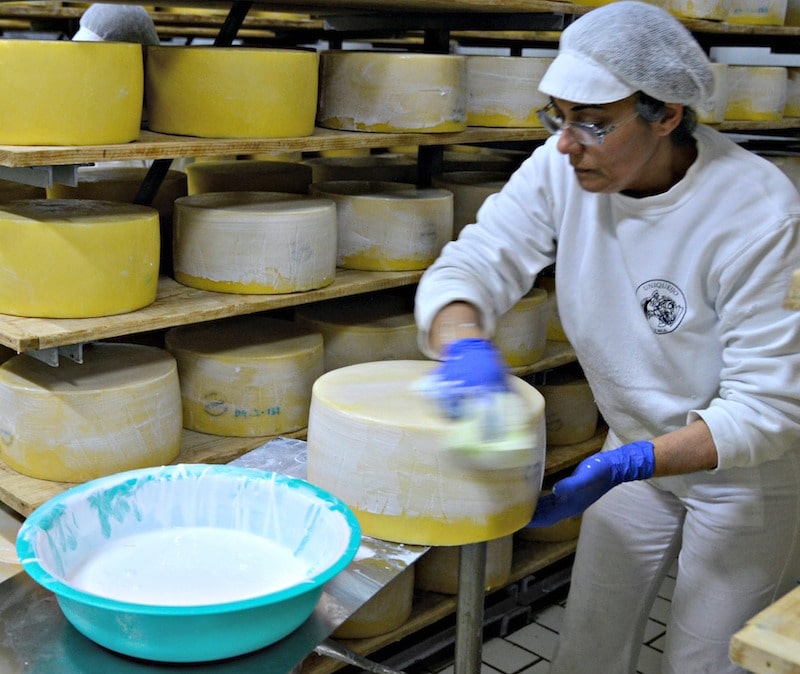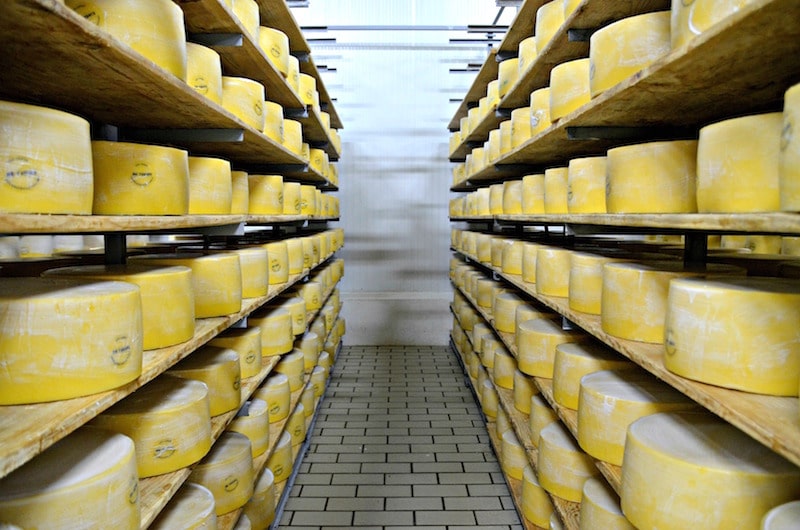
Woman cleaning and preserving the cheese in Sao Jorge
São Jorge Cheese (Queijo São Jorge) is a semi-hard to hard cheese made from unpasteurized cow’s milk specifically on the island of São Jorge — but you’ll be able to find it at restaurants all over the Azores, nine volcanic islands 1,525 kilometers/948 miles off the coast of Portugal. It’s so important it has Protected Geographical Status (PDO) certification, given only to food products of particularly high quality that are also an important part of local tradition.

São Jorge’s uber green landscape. To a cow, this is an endless feast!
São Jorge Cheese has been produced since the 16th century. The island’s topography — 80% is covered by grassy landscape with 9,000 dairy cows — allows for high quality queso made with just cream, rennet (coagulate) and salt. Basically, you’re getting a pure taste of São Jorge without any unnatural additives.
There are three working cheese factories on São Jorge, although the one I explore is Uniqueijo in Beira, as they offer tours of the factory (€1.50 per person) on Tuesdays and Thursdays, but you can contact them to set up a separate time to visit (it’s easiest to have your hotel do it for you).

Sao Jorge Cheese
After dressing up in a plastic gown with showercap and booties, I’m taken through the different phases of cheese-making in real time, from warming the milk to start a culture and adding natural coagulant, to cleaning and molding the cheeses into a perfect round shape. Cheese from every tank must be analyzed based on the shape, the outside and inside appearance and texture, the smell and the taste in a blind tasting by a member from the Confraria do Queijo São Jorge. This is because only the most perfect cheeses can get the PDO label. Realistically, though, if it’s from this island you’re likely getting a high quality product regardless.
The tour ends with a comparative tasting of a young 3-month aged cheese, which has a yellower color and more soft and salty flavor, and a 7-month aged cheese, which is slightly firmer, sharper and even a bit spicy. In fact, my guide informs me that many guests inquire if they add pepper to their older cheeses, when in fact the taste occurs naturally in São Jorge Cheese.

Beautiful views between Topo and Velas
Tip: If you’ve got some extra time, take a drive to the east end of the island to Topo — where São Jorge Cheese originated — and visit Finisterra, another cheese cooperative making São Jorge Cheese as well as a more buttery, fatty Topo cheese that is delicious. Moreover, the drive between Topo and Velas is one of the island’s most scenic stretches, as you see with views of Mount Pico volcano rising above the cloud line, and rolling hills of São Jorge dotted with stone homes and woodland sloping down to the Atlantic.
Logistics:
Uniqueijo, Beira 9800-501 Velas São Jorge; +351 295 438 274/5; lactacores@lactacores.pt
Finisterra, Santo Antão, 9875 – 039 Topo São Jorge; +351 295 415 216; geral@finisterratopo.com

Jessica Festa is the editor of the travel sites Jessie on a Journey (http://jessieonajourney.com) and Epicure & Culture (http://epicureandculture.com). Along with blogging at We Blog The World, her byline has appeared in publications like Huffington Post, Gadling, Fodor’s, Travel + Escape, Matador, Viator, The Culture-Ist and many others. After getting her BA/MA in Communication from the State University of New York at Albany, she realized she wasn’t really to stop backpacking and made travel her full time job. Some of her most memorable experiences include studying abroad in Sydney, teaching English in Thailand, doing orphanage work in Ghana, hiking her way through South America and traveling solo through Europe. She has a passion for backpacking, adventure, hiking, wine and getting off the beaten path.








